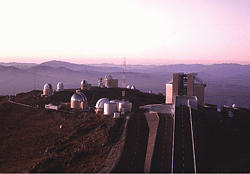Astronomy for the rich - a billion dollar telescope
Dr. Noah Brosh

Since Galileo built a telescope with 16 cm diameter lenses in the 2th century, the observation tools for astronomers have been greatly improved. Among other things, the diameter of the main mirror of the telescopes has increased, whose function is to collect light and concentrate it on a detector that creates an image or captures a spectrum.
With the improvement of ground telescopes, telescopes were also launched into space. The high points in this development are the construction of 4 telescopes with a diameter of 8 meters each, which work as one telescope with a diameter of 16 meters, and the development of the "Hubble" space telescope. Although the diameter of the Hubble is only 2.4 meters, its operation outside the atmosphere allows it to photograph very sharply and to study bodies beyond the ranges of the light spectrum that reach the Earth.
But the astronomers are no longer satisfied with this, and are planning more sophisticated observation tools than these. One of the most daring ideas is that of a team from the European Observatory, operating in Chile, where they plan to build a single telescope with a diameter of 100 meters. Its area will be 100 times larger than the light absorption surface of the largest (only) telescope in the world - aka the "Kek" telescope in Hawaii.
The giant telescope is supposed to be based on a spherical mirror, which will consist of many small mirrors. The huge facility will weigh more than 12 thousand tons. When it scans the sky, it will move with the precision of a Swiss watch. It will be able to photograph pale objects up to 60 thousand times more than what can be photographed or studied today with the most advanced tools. This ability will allow scientists to look deeper into the universe and "get closer to the moment of creation". The only problem is the huge cost of the project, about a billion dollars.
Exploring the universe is becoming very expensive, out of proportion to the number of scientists using this equipment. The construction of the giant telescope must be an international operation. Humanity currently does not have the financial capacity to support more than one or two such observation instruments. Australia may join and budget about 65 million dollars for the project. This is part of the price that Australian science will have to pay to maintain its position in the field. Part of the investment will be returned to the state coffers through taxes from the construction contracts. By the way, the price of the next-generation space telescope (which will be launched at the beginning of the next decade), which will be financed almost entirely by the United States, will also be around one billion dollars.
Israel currently operates a single telescope, only one meter in diameter. An international committee appointed by the US National Academy of Sciences recommended increased support in this field of research, in which Israel has notable achievements. Despite this, as far as budgeting is concerned, almost nothing has moved, this is when Israel has a highly advanced electro-optics industry, which can provide advanced scientific equipment - as part of the cost of joining the international research body.
